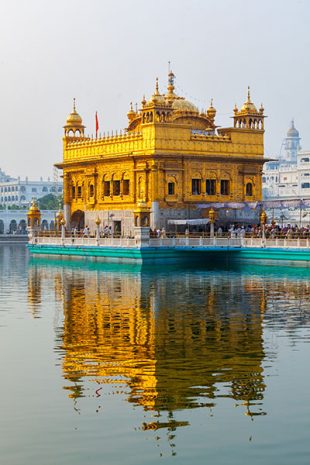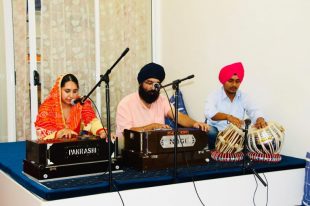What is Gurdwara?
The Guru’s portal or the Guru’s abode, is the name given to a Sikh place of worship. The common translation of the term as temple is not satisfactory for, their faith possessing no sacrificial symbol-ism, Sikhs have neither idols nor altars in their holy places. They have no sacraments and no priestly order. The essential feature of a gurdwara is the presiding presence in it of Sikh Scripture, the Guru Granth Sahib. Ending the line of personal Gurus, Guru Gobind Singh, the tenth Guru installed the sacred volume in 1708 as his eternal successor. The Holy Book has since been the Guru for the Sikhs and it must reign over all Sikh places of worship where religious ceremony focuses around it. Every Sikh place by that token is the house of the Guru hence the name Gurdwara (gur+dwara= the guru’s door).

A second characteristic of a gurdwara is being a public place open to all devotees to pray individually or to assemble in congregation. Its external distinguishing mark is the Nishan Sahib or the Sikh flag, saffron or blue in colour that flies day and night atop the building, or, more often, separately close to it. In early Sikhism, the place used for congregational prayers was called dharamsala, the abode of dharma, different from the modern usage which generally limits the term to a resting place. According to the Janam Sakhis, Guru Nanak wherever he went, called upon his followers to establish dharamsalas and congregate in them to re-peat God’s Name, and to recite His praise. He himself established one at Kartarpur on the bank of the River Ravi where he settled down at the end of his extensive preaching tours. “I have set up a dharamsal of truth,” sang Guru Arjan (1563-1606). “I seek the Sikhs of the Guru (to congregate therein) so that I may serve them and bow at their feel” (GG, 73). In the time of Guru Hargobind (1595-1644), dharamsals began to be called gurdwaras. The change of nomenclature was significant. Guru Arjan had compiled in 1604 a Book, pothi or granth (later Guru Granth Sahib) of holy hymns. Besides his own, he had included in it the compositions of his four spiritual predecessors and of some of the Indian saints and sufis. “The pothi is the-abode of the Divine,” said he (GG, 1226). This first copy of the Granth he installed in the central Sikh shrine, the Harimandar, at Amritsar. Copies of the Granth began to be piously transcribed. The devotees carried them on their heads for installation in their respective dharamsals. Reverently, the Book was called the Granth Sahib and was treated as a sacred embodiment of the Gurus’ revealed utterances.

The main function of the gurdwara is to provide Sikhs with a meeting-place for worship. This mainly consists of listening to the words of the Guru Granth Sahib, singing them to musical accompaniment and hearing them expounded in Katha, or lectures and sermons. The gurdwara also serves as a community centre, a school, a guest house for pilgrims and travellers, occasionally a clinic, and a base for local charitable activities. Apart from morning and evening services, the gurdwaras hold special congregations to mark important anniversaries on the Sikh calendar.
They become scenes of much activities and festivity when celebrations in honour of the birth anniversaries of the Gurus and of the Khalsa take place. The aspect of Sikhism most closely associated with the gurdwara, other than worship, is the institution of Guru Ka Langar or free community kitchen, which encourages commensality. Seva or voluntary service in Guru Ka Langar is considered by Sikhs a pious duty. The gurdwara its hospitality are open to non-Sikhs as well as to members of the faith. The Sikh rahit maryada or code of conduct, however, contains certain rules pertaining to them. For example, no one should enter the gurdwara premises with one’s shoes on or with head uncovered. Other rules in the rahit maryada concern the conduct of religious service and reverence due to the Guru Granth Sahib. Rules also prohibit discrimination in the sangat on the basis of religion, caste, sex or social position, and the observation of idolatrous and superstitious practices.



